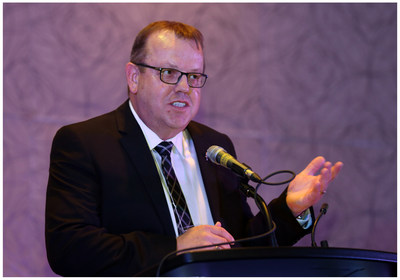Allan Cramm is the FLSmidth 2018 Environmental Management and Stewardship inductee into the International Mining Technology Hall of Fame. Cramm is the Vice President, Innovation and Development focusing on key strategic projects to maximize Anaconda Mining’s assets. He also is part of the development team for new mines and operations. Prior to his promotion, Allan was the General Manager of Anaconda’s Point Rousse project in Baie Verte, Newfoundland and Labrador. He was responsible for the overall operation of the project including permitting, construction, production and special projects.
Dustin Angelo, President & CEO, Anaconda Mining, says “Cramm is an innovative leader and an ‘out-of-the-box’ thinker who has been at the forefront of the growth and development of our Point Rousse project. His leadership has taken pioneering ideas, such as selling the waste rock from our gold mining operation as a construction aggregate product, and made them a reality. I’m pleased to be able to witness how one person’s ingenuity can effect such positive change, not just for our company but for the mining industry.”
Geoff Emberley, CEO & Registrar, PEGNL (Professional Engineers and Geoscientists Newfoundland & Labrador) notes Cramm, “through his leadership has seen many young workers move back to the Baie Verte region and has found ways of challenging them to grow the local economy. Mentors like Cramm are critical to advancing the mining industry in Newfoundland and Labrador.”
One of his principles is ‘Olive’ “the colour you get mixing gold and green.” His “Triple Crown of Environmental Sustainability” involves repurposing coarse mine waste, processing tailings and converting open pit to tailings storage.
For example, the surplus waste produced at Point Rousse gold mine consumed 2.5 million litres of fuel; generated 6.7 Mkg of Co2; required the detonation of 3,600 t of explosive; and required 250 person years of employment. He asked, “Why replicate/”
That waste had favourable chemistry, was suitable as a bulk fill and there was deep water available for shipping. So, an innovative load-out was designed and built.
Repurposing tailings sand involved its chemistry being similar to commercial rock dust. Cramm notes that production of conventional (NPK) fertilizer requires 51 -68 MJ/kg nitrogen; 6.82 MJ/kg phosphorous; and 2.88 MJ/kg potassium. Packaging and transport of conventional fertilizer is about 6-8 MJ/kg. Application of fertilizer (conventional and rock dust) equals 51.62 MJ/kg.
By contrast, the Anaconda Mining material is a byproduct of the gold extraction and does not consume energy for its production.
Cramm explains: “Many people are familiar with using diatomaceous earth (DE) for pest control, but comparatively few are aware that finely ground rock dust can be similar in efficacy and preferable in other respects.”
In repurposing the pit, he notes that in-pit tailings disposal offers a number of advantages over conventional surface impoundments:
- The long-term risks associated with in-pit tailings pit tailings disposal are reduced compared to on-land tailings disposal confined by conventional engineered embankments
- Maintenance of a water cover over the tailings to manage acid rock drainage (ARD) potential is more easily achieved in the Pine Cove pit, compared to an on-land tailings facility.
It increases the long term stability of the pit.











